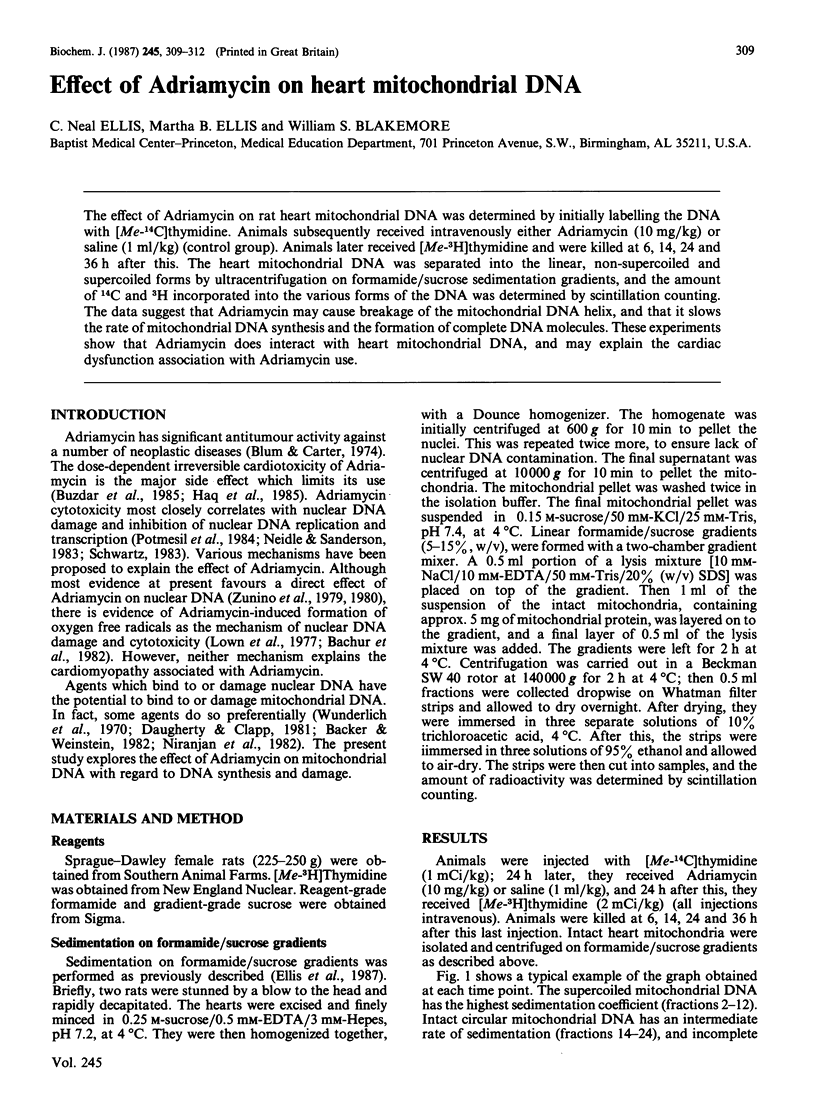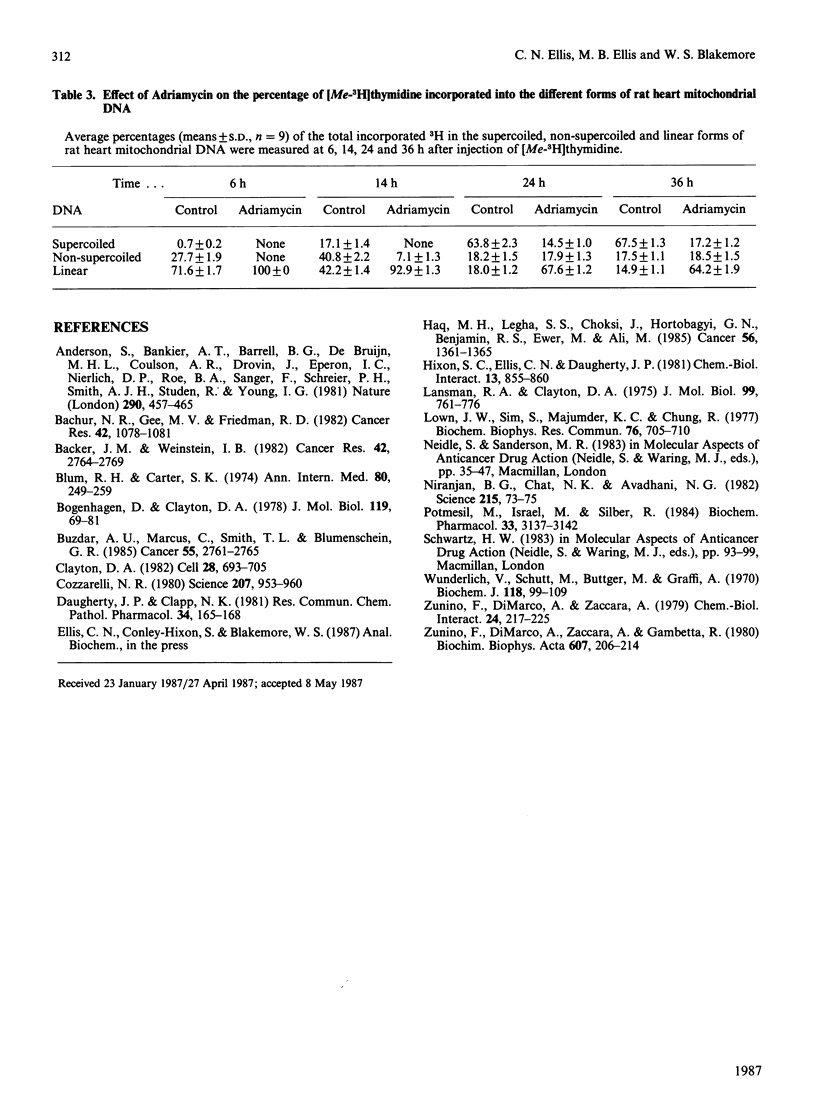Abstract
The effect of Adriamycin on rat heart mitochondrial DNA was determined by initially labelling the DNA with [Me-14C]thymidine. Animals subsequently received intravenously either Adriamycin (10 mg/kg) or saline (1 ml/kg) (control group). Animals later received [Me-3H]thymidine and were killed at 6, 14, 24 and 36 h after this. The heart mitochondrial DNA was separated into the linear, non-supercoiled and supercoiled forms by ultracentrifugation on formamide/sucrose sedimentation gradients, and the amount of 14C and 3H incorporated into the various forms of the DNA was determined by scintillation counting. The data suggest that Adriamycin may cause breakage of the mitochondrial DNA helix, and that it slows the rate of mitochondrial DNA synthesis and the formation of complete DNA molecules. These experiments show that Adriamycin does interact with heart mitochondrial DNA, and may explain the cardiac dysfunction association with Adriamycin use.
Full text
PDF



Selected References
These references are in PubMed. This may not be the complete list of references from this article.
- Anderson S., Bankier A. T., Barrell B. G., de Bruijn M. H., Coulson A. R., Drouin J., Eperon I. C., Nierlich D. P., Roe B. A., Sanger F. Sequence and organization of the human mitochondrial genome. Nature. 1981 Apr 9;290(5806):457–465. doi: 10.1038/290457a0. [DOI] [PubMed] [Google Scholar]
- Bachur N. R., Gee M. V., Friedman R. D. Nuclear catalyzed antibiotic free radical formation. Cancer Res. 1982 Mar;42(3):1078–1081. [PubMed] [Google Scholar]
- Backer J. M., Weinstein I. B. Interaction of benzo(a)pyrene and its dihydrodiol-epoxide derivative with nuclear and mitochondrial DNA in C3H10T 1/2 cell cultures. Cancer Res. 1982 Jul;42(7):2764–2769. [PubMed] [Google Scholar]
- Blum R. H., Carter S. K. Adriamycin. A new anticancer drug with significant clinical activity. Ann Intern Med. 1974 Feb;80(2):249–259. doi: 10.7326/0003-4819-80-2-249. [DOI] [PubMed] [Google Scholar]
- Bogenhagen D., Clayton D. A. Mechanism of mitochondrial DNA replication in mouse L-cells: introduction of superhelical turns into newly replicated molecules. J Mol Biol. 1978 Feb 15;119(1):69–81. doi: 10.1016/0022-2836(78)90270-x. [DOI] [PubMed] [Google Scholar]
- Buzdar A. U., Marcus C., Smith T. L., Blumenschein G. R. Early and delayed clinical cardiotoxicity of doxorubicin. Cancer. 1985 Jun 15;55(12):2761–2765. doi: 10.1002/1097-0142(19850615)55:12<2761::aid-cncr2820551206>3.0.co;2-p. [DOI] [PubMed] [Google Scholar]
- Clayton D. A. Replication of animal mitochondrial DNA. Cell. 1982 Apr;28(4):693–705. doi: 10.1016/0092-8674(82)90049-6. [DOI] [PubMed] [Google Scholar]
- Cozzarelli N. R. DNA gyrase and the supercoiling of DNA. Science. 1980 Feb 29;207(4434):953–960. doi: 10.1126/science.6243420. [DOI] [PubMed] [Google Scholar]
- Daugherty J. P., Clapp N. K. Studies on nitrosamine metabolism. III. Comparison of the subcellular distribution of radioactivity in tissues of RFM and BALB/c mice following administration of [14C]diethylnitrosamine. Res Commun Chem Pathol Pharmacol. 1981 Oct;34(1):165–168. [PubMed] [Google Scholar]
- Haq M. M., Legha S. S., Choksi J., Hortobagyi G. N., Benjamin R. S., Ewer M., Ali M. Doxorubicin-induced congestive heart failure in adults. Cancer. 1985 Sep 15;56(6):1361–1365. doi: 10.1002/1097-0142(19850915)56:6<1361::aid-cncr2820560624>3.0.co;2-s. [DOI] [PubMed] [Google Scholar]
- Hixon S. C., Ellis C. N., Daugherty J. P. Heart mitochondrial DNA synthesis: preferential inhibition by adriamycin. J Mol Cell Cardiol. 1981 Sep;13(9):855–860. doi: 10.1016/0022-2828(81)90242-x. [DOI] [PubMed] [Google Scholar]
- Lansman R. A., Clayton D. A. Selective nicking of mammalian mitochondrial DNA in vivo: photosensitization by incorporation of 5-bromodeoxyuridine. J Mol Biol. 1975 Dec 25;99(4):761–776. doi: 10.1016/s0022-2836(75)80183-5. [DOI] [PubMed] [Google Scholar]
- Lown J. W., Sim S. K., Majumdar K. C., Chang R. Y. Strand scission of DNA by bound adriamycin and daunorubicin in the presence of reducing agents. Biochem Biophys Res Commun. 1977 Jun 6;76(3):705–710. doi: 10.1016/0006-291x(77)91557-1. [DOI] [PubMed] [Google Scholar]
- Niranjan B. G., Bhat N. K., Avadhani N. G. Preferential attack of mitochondrial DNA by aflatoxin B1 during hepatocarcinogenesis. Science. 1982 Jan 1;215(4528):73–75. doi: 10.1126/science.6797067. [DOI] [PubMed] [Google Scholar]
- Potmesil M., Israel M., Silber R. Two mechanisms of adriamycin-DNA interaction in L1210 cells. Biochem Pharmacol. 1984 Oct 15;33(20):3137–3142. doi: 10.1016/0006-2952(84)90069-8. [DOI] [PubMed] [Google Scholar]
- Wunderlich V., Schütt M., Böttger M., Graffi A. Preferential alkylation of mitochondrial deoxyribonucleic acid by N-methyl-N-nitrosourea. Biochem J. 1970 Jun;118(1):99–109. doi: 10.1042/bj1180099. [DOI] [PMC free article] [PubMed] [Google Scholar]
- Zunino F., Di Marco A., Zaccara A., Gambetta R. A. The interaction of daunorubicin and doxorubicin with DNA and chromatin. Biochim Biophys Acta. 1980 Apr 30;607(2):206–214. doi: 10.1016/0005-2787(80)90073-8. [DOI] [PubMed] [Google Scholar]
- Zunino F., Di Marco A., Zaccara A. Molecular structural effects involved in the interaction of anthracyclines with DNA. Chem Biol Interact. 1979 Feb;24(2):217–225. doi: 10.1016/0009-2797(79)90010-3. [DOI] [PubMed] [Google Scholar]


